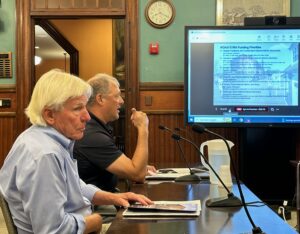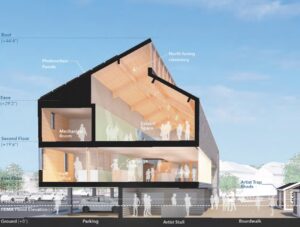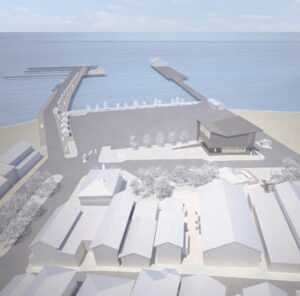PROVINCETOWN — Plans to build a visitor center for the Stellwagen Bank National Marine Sanctuary on town-owned land at the base of MacMillan Pier hit a significant snag last week when Provincetown Select Board members said the current design is too large and expensive.

The National Oceanic and Atmospheric Administration (NOAA) secured a $15-million federal allocation for the project last August, but the full construction costs for the three-story 10,850-square-foot building that the agency has proposed will be $21.3 million, according to a 2021 NOAA projection.
NOAA is looking to the town to provide both the land and additional funds, while the Center for Coastal Studies, the project’s third partner, would run the educational programming at the site.
Without other funding, the plan would leave Provincetown taxpayers on the hook for $6.3 million in construction costs plus continuing operation and maintenance costs, since the visitor center would actually be owned by the town, not the federal government. That math did not appeal to anyone on the select board.
“We need a plan that’s financially viable for the town,” said board member Leslie Sandberg. “I’m concerned about a slippery slope — it’s 6 million now, it could be 12 million a year from now. That’s never going to fly.”
“The building is really, really large,” said board member Erik Borg. “The good news is there might be an opportunity to scale it down” and bring the total cost closer to the $15 million in federal funds that NOAA had already secured, Borg said.

The plans were presented by Peter DeCola, superintendent of the Stellwagen Bank National Marine Sanctuary, and Rich Delaney, CEO of the Center for Coastal Studies. The pair had last briefed the select board on March 8, 2021 in a conversation that focused on potential locations for the visitor center but did not include detailed cost estimates.
“For most of our 48 years, we’ve said the Center for Coastal Studies is the best kept secret in Provincetown,” said Delaney. “A downtown presence would give us the ability to attract more researchers, funding, and the space to grow, so it’s an exciting opportunity for us.”
The building is designed to accommodate 260,000 visitors per year, most of them in the peak summer season, in accordance with a “visitation analysis” from 2017. The cost estimates were from June 2021, and select board members worried they were already obsolete because of a rapid rise in construction costs since then.
“One of the challenging things when you talk about this funding gap is you also have the cost of moving parking spaces over to Route 6,” said board chair Dave Abramson. “Can you tell us what the costs would be for that?”
The visitor center would sit on part of the municipal parking lot at the pier and displace about 60 town-owned parking spaces. A consulting firm presented plans to replace those parking spaces with 60 new ones in the roadbed of Route 6 between Conwell Street and Shank Painter Road in March, but that project would cost about $3.5 million, said Assistant Town Manager Dan Riviello.
“We’re in a housing crisis,” said Sandberg, “and for us to go to town meeting and ask for $3.5 million just for parking and $6 million for this building, and we’ve just done a sewer expansion, Motta Field, and Cannery Wharf Park. I don’t have confidence that this is a good deal for the town.”
Reducing the Cost
Select board member Austin Miller asked if NOAA had considered building the visitor center on National Seashore land at Race Point, but DeCola said that is not something his agency would consider.

“We’re looking for a gateway to the Sanctuary, and that is not it,” said DeCola. “The reason there’s a Stellwagen Bank National Marine Sanctuary is because of this town. It’s our sense of place, our origins and beginnings, and that’s why we want it here.”
Delaney said that the Center for Coastal Studies would staff the visitor center with interpretive specialists but that it had not planned on raising capital for the construction. “We just don’t have the capacity to do capital costs,” Delaney said.
He said he remained optimistic about finding a funding strategy for the project, however. “There are other sources of funds, the state being one of them, and the National Marine Sanctuary Foundation has private sources that could help us raise money,” said Delaney.
DeCola said that it would be possible to strip certain elements from the visitor center, including a community meeting room and the public restrooms on the ground floor, to reduce the overall cost of the project.
The town had requested transportation upgrades including electric charging stations and a redesigned bus stop. Removing those elements “could get us much closer to the $15 million,” DeCola said.
Sandberg said she thought the town was likely to secure electric charging stations through other grants anyway.
“We’re working on it,” said Riviello.
Location Questions
Sandberg and Miller also had reservations about the visitor center’s proposed location along the base of MacMillan Pier, which is in the “velocity zone” on federal flood maps because of its potential exposure to breaking waves.

The select board had endorsed that location in March 2021, but neither Sandberg nor Miller were on the board at that time. Miller said the enhanced requirements for building in a velocity zone were the reason the building struck him as out of scale for the area.
Miller said he favored an alternate spot that the board had passed over in 2021: still on the municipal parking lot but closer to the entrance to the Provincetown Marina and the current bus stop. That area is in the federally defined floodplain but is not in the velocity zone, so a building there would have lower flood-elevation requirements.
Borg asked if the visitor center could be built on the current site of the town’s public restrooms, but the town’s vacuum sewer lines all converge in that area, making construction there impossible, Town Manager Alex Morse said.
Board members floated other locations for the visitor center — including the parking lot next to the CVS pharmacy and the chamber of commerce building at Lopes Square — but DeCola said that reopening the question of location could set the project back irreparably.
“There are things we need to sit down and discuss, but it’s going to be challenging to discuss them without a location,” DeCola said.
The select board ultimately asked DeCola to bring them smaller proposals at the two town parking lot sites — the one at the base of MacMillan and the one nearer to the marina.
“It’s the height” that voters don’t like, Sandberg said. “This is a really good opportunity to resize it and see what happens.”
Scaling the project back is the only sure way to reduce the cost, Abramson said.
“I think we’re looking to be partners here,” Miller said. “We’re just reflecting the concerns and questions of voters and taxpayers.”
That message brought some resolution, and DeCola said he would find out how much it would cost to revise the designs downward.
“I’m glad we’re still partners,” said Delaney. “We’ll work this stuff out.”
